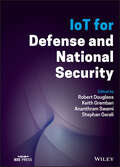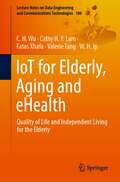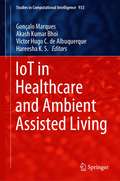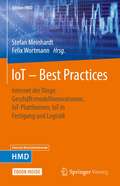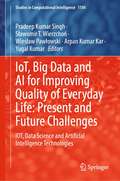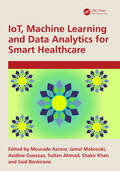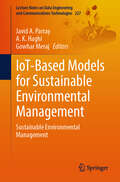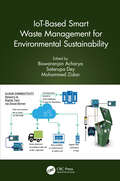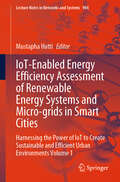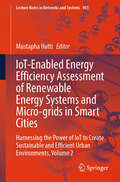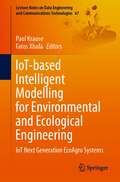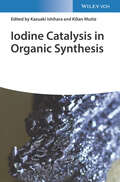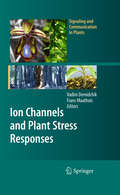- Table View
- List View
IoT for Defense and National Security
by Robert DouglassIoT for Defense and National Security Practical case-based guide illustrating the challenges and solutions of adopting IoT in both secure and hostile environments IoT for Defense and National Security covers topics on IoT security, architecture, robotics, sensing, policy, operations, and more, including the latest results from the premier IoT research initiative of the U.S. Defense Department, the Internet of Battle Things. The text also discusses challenges in converting defense industrial operations to IoT and summarizes policy recommendations for regulating government use of IoT in free societies. As a modern reference, this book covers multiple technologies in IoT including survivable tactical IoT using content-based routing, mobile ad-hoc networks, and electronically formed beams. Examples of IoT architectures include using KepServerEX for edge connectivity and AWS IoT Core and Amazon S3 for IoT data. To aid in reader comprehension, the text uses case studies illustrating the challenges and solutions for using robotic devices in defense applications, plus case studies on using IoT for a defense industrial base. Written by leading researchers and practitioners of IoT technology for defense and national security, IoT for Defense and National Security also includes information on: Changes in warfare driven by IoT weapons, logistics, and systems IoT resource allocation (monitoring existing resources and reallocating them in response to adversarial actions) Principles of AI-enabled processing for Internet of Battlefield Things, including machine learning and inference Vulnerabilities in tactical IoT communications, networks, servers and architectures, and strategies for securing them Adapting rapidly expanding commercial IoT to power IoT for defense For application engineers from defense-related companies as well as managers, policy makers, and academics, IoT for Defense and National Security is a one-of-a-kind resource, providing expansive coverage of an important yet sensitive topic that is often shielded from the public due to classified or restricted distributions.
IoT for Elderly, Aging and eHealth: Quality of Life and Independent Living for the Elderly (Lecture Notes on Data Engineering and Communications Technologies #108)
by Fatos Xhafa C. H. Wu Cathy H. Y. Lam Valerie Tang W. H. IpThis book reflects the recent developments while providing a comprehensive introduction to the Internet of things (IoT) and cloud technologies in transforming aging. IoT has its origins in device connectivity, whereas the cloud grew out of computer science. They can be viewed as two facets of the same field, and together they have undergone substantial development over the past ten years. This book is aimed at advanced undergraduates or first-year research students, as well as researchers and practitioners, and assumes no previous knowledge of IoT and cloud concepts. Basics of computer applications and concepts are required. Some familiarity with gerontechnology would be helpful, though not essential, as this book includes a self-contained introduction to how technology is transforming elderly care and eHealth management. This book aims to give references that offer more detail than is possible here and hopefully provide an entry point into a series of technologies that can improve the quality of life for the elderly. The book includes several case studies explaining how each piece of technology works and its benefits to the elderly. This book is also considered as a simple guide to the technologies for the elderly to use in the community.
IoT for Smart Grid: Revolutionizing Electrical Engineering
by Sanjeevikumar Padmanaban Palanisamy Sivaraman Chenniappan Sharmeela Rahiman ZahiraExpert guidance on technologies to build the Internet of Things (IoT) from electrical engineering and power industry perspectives IoT for Smart Grid presents advanced Internet of Things (IoT) technologies that are utilized in various aspects of smart electrical systems, especially monitoring, diagnosis, automation, and industrial evolution, from the point of view of both electrical engineering and power industry facilities and resources. The book describes how IoT has expanded the use of wireless sensor networks (WSN) to play a vital role in connecting power industry facilities and resources to reduce energy consumption and costs. It also explores concepts of e-mobility that include smart parking, vehicle monitoring, and charging, and considers future challenges such as security and privacy concerns in transactive systems and scalability and standardization issues. Later chapters describe communication protocols for transactive IoT, smart grid integration, cybersecurity challenges, smart energy management, and more. Relevant examples and practical case studies are included to enrich and reinforce learning. Edited by a team of highly qualified professionals in the field, IoT for Smart Grid explores additional topics such as: MQTT, CoAP, and other protocols in transactive systems and WSN diagnostic tools for ensuring reliability and performanceThe role of sensors and actuators in transactive models and significance of transactive IoT in modern applicationsRemote control and automation in smart grids, utilizing IoT for demand response programs, load shifting strategies, and dynamic pricing models and IoT integration IoT for Smart Grid is a definitive reference for identifying and applying advanced technologies and concepts and a highly valuable learning resource for students, researchers, consultants, and utility engineers in the design, use, and maintenance of electrical power systems.
IoT for Smart Grids: Design Challenges and Paradigms (Power Systems)
by Dimitrios Soudris Kostas Siozios Dimitrios Anagnostos Elias KosmatopoulosThis book explains the fundamentals of control theory for Internet of Things (IoT) systems and smart grids and its applications. It discusses the challenges imposed by large-scale systems, and describes the current and future trends and challenges in decision-making for IoT in detail, showing the ongoing industrial and academic research in the field of smart grid domain applications.It presents step-by-step design guidelines for the modeling, design, customisation and calibration of IoT systems applied to smart grids, in which the challenges increase with each system’s increasing complexity. It also provides solutions and detailed examples to demonstrate how to use the techniques to overcome these challenges, as well as other problems related to decision-making for successful implementation. Further, it anaylses the features of decision-making, such as low-complexity and fault-tolerance, and uses open-source and publicly available software tools to show readers how they can design, implement and customise their own system control instantiations.This book is a valuable resource for power engineers and researchers, as it addresses the analysis and design of flexible decision-making mechanisms for smart grids. It is also of interest to students on courses related to control of large-scale systems, since it covers the use of state-of-the-art technology with examples and solutions in every chapter. And last but not least, it offers practical advice for professionals working with smart grids.
IoT for Sustainable Smart Cities and Society (Internet of Things)
by Joel J. P. C. Rodrigues Parul Agarwal Kavita KhannaThis book provides a sound theoretical base and an extensive practical expansion of smart sustainable cities and societies, while also examining case studies in the area to help readers understand IoT driven solutions in smart cities. The book covers fundamentals, applications, and challenges of IoT for sustainable smart cities and society. With a good understanding of IoT and smart cities, and the associated communication protocols, the book provides an insight into its applications in several areas of smart cities. Models, architectures, and algorithms are presented that provide additional solutions. The main challenges discussed that are associated with IoT involved include security, privacy, authenticity, etc. The book is relevant to researchers, academics, professionals, and students.
IoT in Healthcare and Ambient Assisted Living (Studies in Computational Intelligence #933)
by Akash Kumar Bhoi Victor Hugo C. de Albuquerque Gonçalo Marques Hareesha K. S.This book presents the state of the art of Internet of Things (IoT) from the perspective of healthcare and Ambient Assisted Living (AAL). It discusses the emerging technologies in healthcare services used for healthcare professionals and patients for enhanced living environments and public health. The topics covered in this book include emerging eHealth IoT applications, Internet of Medical Things, health sensors, and wearable sensors for pervasive and personalized healthcare, and smart homes applications for enhanced health and well-being. The book also presents various ideas for the design and development of IoT solutions for healthcare and AAL. It will be useful for bioengineers and professionals working in the areas of healthcare as well as health informatics.
IoT – Best Practices: Internet der Dinge, Geschäftsmodellinnovationen, IoT-Plattformen, IoT in Fertigung und Logistik (Edition HMD)
by Stefan Meinhardt Felix WortmannDas Internet der Dinge (Internet of Things – IoT) ist längst Realität. Mehr oder weniger intelligente Dinge messen, analysieren und kommunizieren weltweit, verbunden über das Internet, mit anderen Dingen. Sei es die Optimierung eines bestehenden Prozesses, die Erweiterung eines solchen, ein smartes Produkt oder gleich der Aufbau eines völlig neuen Geschäftsmodells – IoT-Konzepte bilden oft die Grundlage dafür. Das grundsätzliche Potential (Warum?) des Internets der Dinge ist vielfach bewiesen. Das „Wie?“ und das „Wofür?“ sind die Fragen, die es zu beantworten gilt. Welche Prozesse bieten das meiste Potential für eine Vernetzung? An welchen Stellen steht der Aufwand nicht im Verhältnis zum Mehrwert? Welche Technologien stehen zur Verfügung und passen zum entsprechenden Szenario? Wie müssen Geschäftspartner in einem Ecosystem eingebunden werden und welche sicherheitsrelevanten oder auch rechtlichen Probleme gilt es zu lösen?Die Autoren aus Wissenschaft und Praxis des vorliegenden Werkes greifen in ihren Beiträgen genau diese Fragestellungen auf und bieten konzeptionelle, prototypische bzw. praxisnahe Antworten und Lösungswege an.
IoT, AI, and ICT for Educational Applications: Technologies to Enable Education for All (EAI/Springer Innovations in Communication and Computing)
by Stamatios PapadakisThis book provides insight into the importance of advanced innovative technologies such as the Internet of Things (IoT), artificial intelligence (AI), and Metaverse as part of information and communication technology (ICT) solutions in education. Key features of this book include the recent and emerging developments in various specializations in education and finding their solutions by incorporating IoT, AI and ICT. This book presents useful applications, interventions, and case studies that cater to their improved requirements. Topics include formal and services based on IoT; AI technology for IoT-based educational delivery; interfacing devices to IoT; smart educational services; ChatGPT; Smartbots; and more. The authors include several practical solutions and applications of IoT and ICT in education. The book applies to researchers, academics, students, educators and practitioners around the world.
IoT, Big Data and AI for Improving Quality of Everyday Life: IOT, Data Science and Artificial Intelligence Technologies (Studies in Computational Intelligence #1104)
by Arpan Kumar Kar Pradeep Kumar Singh Yugal Kumar Wiesław Pawłowski Sławomir T. WierzchońThis book focuses mainly on the usages of three key technologies: IoT, big data, and AI for various day to day applications. Further, it explores the possibilities of future research based on the usages of latest information systems.This book explores the current research and challenges to be faced by different researchers for building intelligent information solutions using key technologies; IoT, big data, and AI in improving quality of lives in smart cities and explores the limitations and capabilities of these three key computing technologies. The book is organized into three major parts; each part includes chapters exploring a specific topic, and there are: PART-1: IoT for Real World Solutions , (ii) Part-2: Big Data And Cloud Computing for Innovative Solutions For Day to Day Lives, and (iii) Part-3 Artificial Intelligence for Everyday Lives. This book may be useful to the scientists, scholars, and researchers who are working in the field of computer science and engineering, and communication engineering, along with the students in these subjects who are working or willing to work on IoT, big data, and AI technologies for improving quality of everyday life. Specialists as well as student readers find the book chapters encouraging and helpful.IoT, data science & cloud, and AI all are the undergraduate (UG/ bachelor) subjects. Use of these three key technologies for building new applications for better world is helpful for UG and postgraduate (PG/ MS) Programmes students (as an elective and core course). This book may also be very useful for the Ph.D. (research scholars) during their course work and may be used as an instrument to identify the different challenges associated with information systems.
IoT, Blockchain, and Smart Healthcare: Integration Techniques and Case Studies (Innovations in Health Informatics and Healthcare)
by Manoj Kumar Mazdak Zamani Rohit Tanwar Neelu Jyothi Ahuja Urmila PilaniaThe book examines the integration of Internet of Things (IoT), blockchain, and smart healthcare, providing a comprehensive analysis of these advanced technologies and their impact on the healthcare industry. It offers practical examples of how blockchain and IoT devices can be used to address real-world healthcare challenges and overcome the hurdles of implementing them in the healthcare sector.IoT, Blockchain, and Smart Healthcare: Integration Techniques and Case Studies provides a detailed exploration of how these technologies are combined, giving readers a deep understanding of their role in revolutionizing healthcare. It explores the practical applications of blockchain and IoT devices in solving healthcare problems and addresses the challenges of incorporating these technologies into healthcare systems. The book also provides practical guidance on implementing cutting-edge methodologies, enabling readers to apply theoretical knowledge in real-world situations effectively.By bridging the gap between technology and healthcare, this book makes complex concepts understandable to a wide audience, including healthcare professionals, researchers, technology enthusiasts, and policymakers.
IoT, Machine Learning and Blockchain Technologies for Renewable Energy and Modern Hybrid Power Systems
by P. Sanjeevikumar P. Sivaraman C. Sharmeela Meera JosephThis edited book comprises chapters that describe the IoT, machine learning, and blockchain technologies for renewable energy and modern hybrid power systems with simulation examples and case studies. After reading this book, users will understand recent technologies such as IoT, machine learning techniques, and blockchain technologies and the application of these technologies to renewable energy resources and modern hybrid power systems through simulation examples and case studies.
IoT, Machine Learning and Data Analytics for Smart Healthcare
by Mourade Azrour Jamal Mabrouki Azidine Guezzaz Said Benkirane Sultan Ahmad Shakir KhanMachine learning, Internet of Things (IoT) and data analytics are new and fresh technologies that are being increasingly adopted in the field of medicine. This book positions itself at the forefront of this movement, exploring the beneficial applications of these new technologies and how they are gradually creating a smart healthcare system. This book details the various ways in which machine learning, data analytics and IoT solutions are instrumental in disease prediction in smart healthcare. For example, wearable sensors further help doctors and healthcare managers to monitor patients remotely and collect their health parameters in real-time, which can then be used to create datasets to develop machine learning models that can aid in the prediction and detection of any susceptible disease. In this way, smart healthcare can provide novel solutions to traditional medical issues. This book is a useful overview for scientists, researchers, practitioners and academics specialising in the field of intelligent healthcare, as well as containing additional appeal as a reference book for undergraduate and graduate students
IoT-Based Models for Sustainable Environmental Management: Sustainable Environmental Management (Lecture Notes on Data Engineering and Communications Technologies #227)
by A. K. Haghi Javid A. Parray Gowhar MerajThis book is a testament to the dynamic intersection of environmental responsibility and the applications of IoT-based models for reader. The applications of IoT-based models, ranging from environmental sustainability and the impact of environmental pollution to human health, sustainable production, and conservation of natural resources, have long grappled with the challenges posed by waste management. It provides: A transformative solution. Sustainability and efficiency of earth protection operations. New ideas with global views and state-of-the-art results and fosters a culture of environmental stewardship. The book evaluates the environmental, economic, and social impacts of new technologies, shedding light on their potential to transform environmental facilities into models of sustainability. It provides valuable information on best practices, case studies, and practical guidance for integrating new models for environment sustainability. By addressing the varied needs of these stakeholders, it facilitates informed decision-making and promotes sustainable development with global perspectives. It will also serve as a valuable reference, inspiring innovation, fostering collaboration, and driving progress in the application of IoT technologies in environment sustainability.
IoT-Based Smart Waste Management for Environmental Sustainability (Smart and Intelligent Computing in Engineering)
by Biswaranjan Acharya, Satarupa Dey, and Mohammed ZidanThis book consolidates and summarizes smart technologies like IoT, edge computing, and AI used in different aspects of waste material management, mitigation, and recycling for a sustainable environment. One of the cases explains how IoT-based systems and wireless sensors can be used to continuously detect common pollutants such as volatile organic compounds (VOCs), carbon monoxide, and particulate matter (PM) and how the data collected are used to assess the overall air quality and determine actions for improvements. A collection of practical case studies, this book provides a comprehensive knowledge in smart waste management to readers in universities, research centers, and industries.
IoT-Enabled Energy Efficiency Assessment of Renewable Energy Systems and Micro-grids in Smart Cities: Harnessing the Power of IoT to Create Sustainable and Efficient Urban Environments Volume 1 (Lecture Notes in Networks and Systems #984)
by Mustapha HattiThis book embarks on a transformative exploration of sustainable urban development, integrating Internet of Things (IoT) technologies in energy efficiency assessments of renewable energy systems and microgrids within smart cities. This work transcends conventional approaches, seamlessly blending theoretical insights with practical applications, and prioritizing real-time, IoT-enabled assessments for optimal energy utilization. Evolving the understanding of renewable energy systems and microgrids, the book distinguishes itself through its hands-on application of IoT technologies. It not only delves into theoretical aspects but also equips readers with actionable insights, guiding the implementation of IoT for informed decision-making in the dynamic landscape of smart city environments. From IoT sensor deployment strategies to data analytics techniques and practical considerations, the book's expansive scope offers a comprehensive roadmap for creating resilient and efficient energy ecosystems. Tailored for professionals, researchers, and policymakers in energy management, urban planning, and IoT technology, this resource speaks to a diverse audience. Whether the reader is an engineer aiming to optimize microgrid performance or a policymaker driving urban sustainability, the book provides indispensable insights. It serves as a compass, informing city planners on energy-efficient infrastructure, guiding researchers in developing impactful IoT applications, and assisting policymakers in formulating forward-thinking, eco-friendly regulations. In a world embracing smart technologies, this book emerges as an essential guide, steering stakeholders toward a future where the seamless integration of energy efficiency and IoT defines the landscape of truly smart and sustainable cities.
IoT-Enabled Energy Efficiency Assessment of Renewable Energy Systems and Micro-grids in Smart Cities: Harnessing the Power of IoT to Create Sustainable and Efficient Urban Environments, Volume 2 (Lecture Notes in Networks and Systems #983)
by Mustapha HattiThis book embarks on a transformative exploration of sustainable urban development, integrating Internet of Things (IoT) technologies in energy efficiency assessments of renewable energy systems and microgrids within smart cities. This work transcends conventional approaches, seamlessly blending theoretical insights with practical applications, and prioritizing real-time, IoT-enabled assessments for optimal energy utilization. Evolving the understanding of renewable energy systems and microgrids, the book distinguishes itself through its hands-on application of IoT technologies. It not only delves into theoretical aspects but also equips readers with actionable insights, guiding the implementation of IoT for informed decision-making in the dynamic landscape of smart city environments. From IoT sensor deployment strategies to data analytics techniques and practical considerations, the book's expansive scope offers a comprehensive roadmap for creating resilient and efficient energy ecosystems. Tailored for professionals, researchers, and policymakers in energy management, urban planning, and IoT technology, this resource speaks to a diverse audience. Whether the reader is an engineer aiming to optimize microgrid performance or a policymaker driving urban sustainability, the book provides indispensable insights. It serves as a compass, informing city planners on energy-efficient infrastructure, guiding researchers in developing impactful IoT applications, and assisting policymakers in formulating forward-thinking, eco-friendly regulations. In a world embracing smart technologies, this book emerges as an essential guide, steering stakeholders toward a future where the seamless integration of energy efficiency and IoT defines the landscape of truly smart and sustainable cities.
IoT-based Intelligent Modelling for Environmental and Ecological Engineering: IoT Next Generation EcoAgro Systems (Lecture Notes on Data Engineering and Communications Technologies #67)
by Fatos Xhafa Paul KrauseThis book brings to readers thirteen chapters with contributions to the benefits of using IoT and Cloud Computing to agro-ecosystems from a multi-disciplinary perspective. IoT and Cloud systems have prompted the development of a Cloud digital ecosystem referred to as Cloud-to-thing continuum computing. The key success of IoT computing and the Cloud digital ecosystem is that IoT can be integrated seamlessly with the physical environment and therefore has the potential to leverage innovative services in agro-ecosystems. Areas such as ecological monitoring, agriculture, and biodiversity constitute a large area of potential application of IoT and Cloud technologies. In contrast to traditional agriculture systems that have employed aggressive policies to increase productivity, new agro-ecosystems aim to increase productivity but also achieve efficiency and competitiveness in modern sustainable agriculture and contribute, more broadly, to the green economy and sustainable food-chain industry. Fundamental research as well as concrete applications from various real-life scenarios, such as smart farming, precision agriculture, green agriculture, sustainable livestock and sow farming, climate threat, and societal and environmental impacts, is presented. Research issues and challenges are also discussed towards envisioning efficient and scalable solutions to agro-ecosystems based on IoT and Cloud technologies. Our fundamental belief is that we can collectively trigger a new revolution that will transition agriculture into an equable system that not only feeds the world, but also contributes to mitigating the climate change and biodiversity crises that our historical actions have triggered.
IoT-enabled Smart Healthcare Systems, Services and Applications
by Neeraj Kumar Shalli Rani Maheswar Rajagopal Syed Hassan Ahmed Shah>IoT-Enabled Smart Healthcare Systems, Services and Applications Explore the latest healthcare applications of cutting-edge technologies In IoT-Enabled Smart Healthcare Systems, Services and Applications, an accomplished team of researchers delivers an insightful and comprehensive exploration of the roles played by cutting-edge technologies in modern healthcare delivery. The distinguished editors have included resources from a diverse array of learned experts in the field that combine to create a broad examination of a rapidly developing field. With a particular focus on Internet of Things (IoT) technologies, readers will discover how new technologies are impacting healthcare applications from remote monitoring systems to entire healthcare delivery methodologies. After an introduction to the role of emerging technologies in smart health care, this volume includes treatments of ICN-Fog computing, edge computing, security and privacy, IoT architecture, vehicular ad-hoc networks (VANETs), and patient surveillance systems, all in the context of healthcare delivery. Readers will also find: A thorough introduction to ICN-Fog computing for IoT based healthcare, including its architecture and challenges Comprehensive explorations of Internet of Things enabled software defined networking for edge computing in healthcare Practical discussions of a review of e-healthcare systems in India and Thailand, as well as the security and privacy issues that arise through the use of smart healthcare systems using Internet of Things devices In-depth examinations of the architecture and applications of an Internet of Things based healthcare system Perfect for healthcare practitioners and allied health professionals, hospital administrators, and technology professionals, IoT-Enabled Smart Healthcare Systems, Services and Applications is an indispensable addition to the libraries of healthcare regulators and policymakers seeking a one-stop resource that explains cutting-edge technologies in modern healthcare.
IoT/AI Control of VRF Distributed Building Air-Conditioners
by Chuzo NinagawaThis book describes new energy service controls of VRF (Variable Refrigerant Flow) air-conditioners, i.e., distributed-type air-conditioners for commercial buildings in the near future, in the context of the energy savings for CO2 reduction and the reform of the electric power system. In other words, this book introduces the state-of-the-art technology of the next-generation distributed building air-conditioning energy service system, from IoT cloud control to AI optimal control, as well as standards for the smart grid supply and demand adjustment market. Rather than simple saving energy by On Off operations or shifting set- temperatures, the author proposes technology that sends numerical commands for the air-conditioner inverters directly from the cloud. By using this innovative IoT method, this book describes how to realizes the AI optimal cloud control as a cluster of air-conditioners while machine-learning of each air conditioner's situation.
IoT: Security and Privacy Paradigm (Internet of Everything (IoE) #63)
by Dac-Nhuong Le Vicente García Díaz Souvik PalIOT: Security and Privacy Paradigm covers the evolution of security and privacy issues in the Internet of Things (IoT). It focuses on bringing all security and privacy related technologies into one source, so that students, researchers, and practitioners can refer to this book for easy understanding of IoT security and privacy issues. This edited book uses Security Engineering and Privacy-by-Design principles to design a secure IoT ecosystem and to implement cyber-security solutions. This book takes the readers on a journey that begins with understanding the security issues in IoT-enabled technologies and how it can be applied in various aspects. It walks readers through engaging with security challenges and builds a safe infrastructure for IoT devices. The book helps readers gain an understand of security architecture through IoT and describes the state of the art of IoT countermeasures. It also differentiates security threats in IoT-enabled infrastructure from traditional ad hoc or infrastructural networks, and provides a comprehensive discussion on the security challenges and solutions in RFID, WSNs, in IoT. This book aims to provide the concepts of related technologies and novel findings of the researchers through its chapter organization. The primary audience includes specialists, researchers, graduate students, designers, experts and engineers who are focused on research and security related issues. Souvik Pal, PhD, has worked as Assistant Professor in Nalanda Institute of Technology, Bhubaneswar, and JIS College of Engineering, Kolkata (NAAC "A" Accredited College). He is the organizing Chair and Plenary Speaker of RICE Conference in Vietnam; and organizing co-convener of ICICIT, Tunisia. He has served in many conferences as chair, keynote speaker, and he also chaired international conference sessions and presented session talks internationally. His research area includes Cloud Computing, Big Data, Wireless Sensor Network (WSN), Internet of Things, and Data Analytics. Vicente García-Díaz, PhD, is an Associate Professor in the Department of Computer Science at the University of Oviedo (Languages and Computer Systems area). He is also the editor of several special issues in prestigious journals such as Scientific Programming and International Journal of Interactive Multimedia and Artificial Intelligence. His research interests include eLearning, machine learning and the use of domain specific languages in different areas. Dac-Nhuong Le, PhD, is Deputy-Head of Faculty of Information Technology, and Vice-Director of Information Technology Apply and Foreign Language Training Center, Haiphong University, Vietnam. His area of research includes: evaluation computing and approximate algorithms, network communication, security and vulnerability, network performance analysis and simulation, cloud computing, IoT and image processing in biomedical. Presently, he is serving on the editorial board of several international journals and has authored nine computer science books published by Springer, Wiley, CRC Press, Lambert Publication, and Scholar Press.
Iodine Catalysis in Organic Synthesis
by Kazuaki IshiharaIodine Catalysis in Organic Synthesis The first book of its kind to highlight iodine as a sustainable alternative to conventional transition metal catalysis Iodine Catalysis in Organic Synthesis provides detailed coverage of recent advances in iodine chemistry and catalysis, focusing on the utilization of various iodine-containing compounds as oxidative catalysts. Featuring contributions by an international panel of leading research chemists, this authoritative volume explores the development of environmentally benign organic reactions and summarizes catalytic transformations of molecular iodine and iodine compounds such as hypervalent organoiodine and inorganic iodine salts. Readers are first introduced to the history of iodine chemistry, the conceptual background of homogeneous catalysis, and the benefits of iodine catalysis in comparison with transition metals. Next, chapters organized by reaction type examine enantioselective transformations, catalytic reactions involving iodine, catalyst states, oxidation in iodine and iodine catalyses, and catalytic reactions based on halogen bonding. Practical case studies and real-world examples of different applications in organic synthesis and industry are incorporated throughout the text. An invaluable guide for synthetic chemists in both academic and industrial laboratories, Iodine Catalysis in Organic Synthesis: Provides a thorough overview of typical iodine-catalyzed reactions, catalyst systems, structures, and reactivity Explores promising industrial applications of iodine-based reagents for organic synthesis Highlights the advantages iodine catalysis has over classical metal-catalyzed reactions Discusses sustainable and eco-friendly methods in hypervalent iodine chemistry Edited by two world authorities on the catalytic applications of organoiodine compounds, Iodine Catalysis in Organic Synthesis is required reading for catalytic, organic, and organometallic chemists, medicinal and pharmaceutical chemists, industrial chemists, and academic researchers and advanced students in relevant fields.
Ion Beam Analysis: Fundamentals and Applications
by Michael Nastasi James W. Mayer Yongqiang WangIon Beam Analysis: Fundamentals and Applications explains the basic characteristics of ion beams as applied to the analysis of materials, as well as ion beam analysis (IBA) of art/archaeological objects. It focuses on the fundamentals and applications of ion beam methods of materials characterization.The book explains how ions interact with solids
Ion Beam Induced Defects and Their Effects in Oxide Materials (SpringerBriefs in Physics)
by Vinod Kumar Parmod Kumar Jitendra Pal Singh K. AsokanThis book provides an overview of the applications of ion beam techniques in oxide materials. Oxide materials exhibit defect-induced physical properties relevant to applications in sensing, optoelectronics and spintronics. Defects in these oxide materials also lead to magnetism in non-magnetic materials or to a change of magnetic ordering in magnetic materials. Thus, an understanding of defects is of immense importance. To date, ion beam tools are considered the most effective techniques for producing controlled defects in these oxides. This book will detail the ion beam tools utilized for creating defects in oxides.
Ion Beams in Materials Processing and Analysis
by Klaus Wetzig Bernd SchmidtA comprehensive review of ion beam application in modern materials research is provided, including the basics of ion beam physics and technology. The physics of ion-solid interactions for ion implantation, ion beam synthesis, sputtering and nano-patterning is treated in detail. Its applications in materials research, development and analysis, developments of special techniques and interaction mechanisms of ion beams with solid state matter result in the optimization of new material properties, which are discussed thoroughly. Solid-state properties optimization for functional materials such as doped semiconductors and metal layers for nano-electronics, metal alloys, and nano-patterned surfaces is demonstrated. The ion beam is an important tool for both materials processing and analysis. Researchers engaged in solid-state physics and materials research, engineers and technologists in the field of modern functional materials will welcome this text.
Ion Channels and Plant Stress Responses
by Frans J.M. Maathuis Vadim DemidchikThis book aims to provide a range of perspectives on an area that is very topical at present in plant biology: the role of ion channels in plant stress responses. Functions of cation and anion channels in the sensing and encoding of major biotic and abiotic stimuli, stress signal transduction and metabolism adjustment are examined at the cellular and molecular levels. Particular emphases of the book are on new insights into plant Ca2+ signaling, salinity tolerance mechanisms, cyclic nucleotide gated channels and the regulation of stress reactions among oxygen-derived species.
